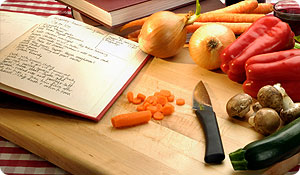
If you or someone in your family suffers from food allergies, you probably go to great lengths to cook up allergy-free meals and treats. This can pose quite a challenge, though, since many popular recipes contain ingredients that could trigger allergy symptoms. Some may even cause a dangerous, or life threatening, reaction. But the experts say that with a little planning and creativity, cooking with food allergies can be easier than you might imagine.
Weigh Each Recipe
Want to cook allergy-free foods that are both delicious and safe to eat? The experts say that the key to successfully cooking with food allergies is to know your recipes and the ingredients they contain. Then you can make strategic changes as needed. Take a baking recipe that calls for eggs, for instance. If you are allergic to eggs, in order to successfully replace them, need to know the purpose this ingredient serves in order to find an alternative that can accomplish the same goal. For instance, do the eggs thicken the batter, baste it or help it leaven? Once you know this answer, you can find something that will offer similar results without causing an allergic reaction.
Common Egg Substitutions
Review some of the following examples of egg substitutions:
- Banana
- Applesauce
- Flax seed
- Gelatin
Wheat Alternatives
In a similar vein, if you have a wheat allergy, there are several approaches you can take to replace the wheat flour when you bake. Further, you can select a one-ingredient product, or you may prefer a mixture made from several items. Consider some of the options provided below that can be adequate wheat replacements:
- Rice flour
- Chick pea flour
- Potato starch
- Ground rolled oats
- Tapioca flour
- Oat, barley and rice flour combined
- A mix of rye flour and potato flour
- Sweet rice flour, potato flour and tapioca flour
Milk Replacements
Milk can be replaced with one of several substances that might meet the same goals. Consider the possibilities included in the list below:
- Soy milk
- Rice milk
- Oat milk
Learn More
When cooking with food allergies, keep in mind that you don't have to go it alone. While you may need to experiment with different items to get the consistency you desire, you can find a wealth of information and suggestions from the experts online that can help guide your cooking efforts. For instance, the Kids with Food Allergies website offers more specifics on what types of substitutions work the best for different recipes and how much to use and when. You can also get allergy-free recipes perfect for holidays and special occasions through the American Academy of Allergy, Asthma and Immunology.
Sources:
American Academy of Allergy, Asthma and Immunology
http://www.aaaai.org/patients/specialfeature/recipes.stm
https://www.aaaai.org/patients/advocate/2007/fall/fall07.pdf
Kids with Food Allergies
http://www.kidswithfoodallergies.org/resourcespre.php?id=63&title=Food_allergy_cooking_basics
http://www.aaaai.org/search/?cx=010195695855076926430%3A3j7wmn664zg&cof=FORID%3A11&q=allergy-free+foods&sa=GO#915





